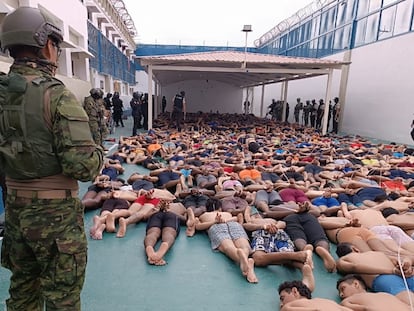State of emergency declared in Ecuador as security crisis worsens
President Daniel Noboa made the decision a day after the most dangerous criminal in the country, José Adolfo Macías, alias Fito, escaped from prison. The measure involves a three-month curfew
Ecuador experienced another day of chaos, violence and uncertainty. Since the early morning of January 8, six prisons in the country have been taken over by inmates who kidnapped prison guards and started fights inside the penitentiary centers. The unrest was captured in videos recorded by the prisoners. The footage showed security guards on the floor, with knives and guns to their heads, forced to repeat the same message: that the government should reverse its decision to transfer prisoners. Faced with the out-of-control situation, Ecuadorian President Daniel Noboa decided on Monday to decree the first state of emergency of his mandate, which began on November 23.
Fire sirens woke up the inmates of the Inca prison, in the north of the Ecuadorian capital. Prisoners burned mattresses in the yard and one managed to escape, although he was captured hours later. Police later managed to regain control of the center. In Turi prison, in the city of Cuenca, prisoners took to the roofs, some of them wearing hats in the shape of wolves, the symbol of the criminal gang of the same name. The unrest escalated, with the inmates destroying the prison’s security cameras. Similar crises were witnessed in four other prisons, where inmates kidnapped almost 100 prison workers.
In the face of the violent escalation, Noboa decreed a state of emergency, which will last 60 days. This same measure was applied on 20 occasions by his predecessor Guillermo Lasso. The state of emergency establishes a curfew between 11 p.m. and 5 a.m., and designates penitentiary centers as security zones, meaning the military can operate in the surrounding areas and control vehicles passing through the perimeter.
The unrest inside the prisons moved to the streets, particularly in Esmeraldas province, where three attacks with explosives were registered in different cities. One of the attacks was near the police headquarters in Esmeraldas, one of the provinces with the highest rates of violence in the country. According to authorities, there were 8,008 homicides in Ecuador in 2023. Of these, 91% were attributed to criminal violence related to drug trafficking.
Tensions in Ecuador rose on Sunday after José Adolfo Macías, alias Fito, Ecuador’s most dangerous criminal, escaped from the Guayaquil Regional prison with four other people in his security circle. Authorities at SNAI, the entity in charge of controlling prisons, realized he had fled when they found his cell empty during a police and military operation to seize weapons and prohibited objects. The government has not yet acknowledged that Fito — the leader of the criminal gang Los Choneros — has escaped, saying only that he “has not appeared.” However, Ecuador’s Public Prosecutor’s Office has filed charges against two prison officials who were allegedly involved in helping the criminal to escape.
Sign up for our weekly newsletter to get more English-language news coverage from EL PAÍS USA Edition
Tu suscripción se está usando en otro dispositivo
¿Quieres añadir otro usuario a tu suscripción?
Si continúas leyendo en este dispositivo, no se podrá leer en el otro.
FlechaTu suscripción se está usando en otro dispositivo y solo puedes acceder a EL PAÍS desde un dispositivo a la vez.
Si quieres compartir tu cuenta, cambia tu suscripción a la modalidad Premium, así podrás añadir otro usuario. Cada uno accederá con su propia cuenta de email, lo que os permitirá personalizar vuestra experiencia en EL PAÍS.
¿Tienes una suscripción de empresa? Accede aquí para contratar más cuentas.
En el caso de no saber quién está usando tu cuenta, te recomendamos cambiar tu contraseña aquí.
Si decides continuar compartiendo tu cuenta, este mensaje se mostrará en tu dispositivo y en el de la otra persona que está usando tu cuenta de forma indefinida, afectando a tu experiencia de lectura. Puedes consultar aquí los términos y condiciones de la suscripción digital.
More information
Archived In
Últimas noticias
Most viewed
- Sinaloa Cartel war is taking its toll on Los Chapitos
- Oona Chaplin: ‘I told James Cameron that I was living in a treehouse and starting a permaculture project with a friend’
- Reinhard Genzel, Nobel laureate in physics: ‘One-minute videos will never give you the truth’
- Why the price of coffee has skyrocketed: from Brazilian plantations to specialty coffee houses
- Silver prices are going crazy: This is what’s fueling the rally










































